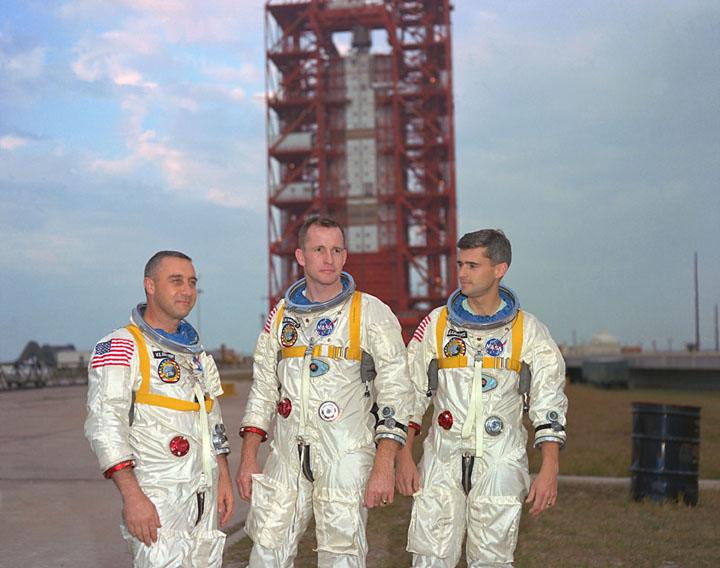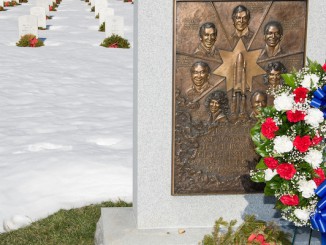STORY WRITTEN FOR CBS NEWS & USED WITH PERMISSION

With the first Apollo launch less than a month away, America’s race to the moon was in high gear. The three-man crew of the first Apollo test flight — commander Virgil “Gus” Grissom, Ed White and Roger Chaffee — strapped into the cockpit of their spacecraft on Jan. 27, 1967 — 50 years ago Friday — for a dress-rehearsal countdown.
Wearing bulky spacesuits, the astronauts climbed aboard at 1 p.m. for a “plugs out” test, meaning the spacecraft would be sealed and pressurized with 100 percent oxygen just as it would be during the real countdown and launch.
The Saturn 1B rocket atop pad 34 at what is now the Cape Canaveral Air Force Station was not fueled for flight and the test was not considered hazardous. But almost from the start, problems cropped up triggering one delay after another.
Grissom, the second American in space and commander of the first two-man Gemini mission reported a strange “sour buttermilk” odor in the oxygen flowing into his suit, prompting an unplanned hold in the countdown. The crew collected an air sample for later analysis and the countdown resumed.
A few minutes later, engineers began bolting on the Apollo capsule’s three-piece hatch, a complex procedure that, in theory, could be reversed by the crew in about 90 seconds. Once the hatch was in place, the cabin was pressurized with oxygen. All standard procedure.
A master alarm repeatedly went off because of an apparent high oxygen flow indication in the cockpit system. Again, the crew discussed the matter with environment control system engineers and decided the alarms likely were the result of the astronauts moving about slightly in their seats.
A more serious problem developed later in the countdown. Grissom had problems communicating with engineers in a nearby blockhouse, angrily remarking at one point: “How are we going to get to the moon if we can’t talk between two or three buildings?”
Test conductor Clarence Chauvin later testified “the overall communications problem was so bad at times that we could not even understand what the crew was saying,”
Tom Stafford, a veteran astronaut who was working in Los Angeles that night with crewmates John Young and Eugene Cernan had similar trouble during tests at the North American factory where the Apollo capsules were built.
“Things were going so bad with the tests I was in charge of running in that spacecraft, the glycol (coolant) was leaking, there were electrical shorts, communications were cutting out,” Stafford said Friday during a memorial at the Kennedy Space Center. “I remember, John Young said ‘go to the moon? Hell, this thing will never make it to Earth orbit.’ It was so bad I called the test office and said we’ll come back when you get this spacecraft fixed.”
The communications problems at the Cape prompted a hold in the countdown at 5:40 p.m. At 6:31 p.m., test conductors were preparing to resume the countdown when telemetry indicated an unusual rise in the oxygen flow to the crew’s spacesuits.
Four seconds later, one of the astronauts, presumably Chaffee, uttered four heart-stopping words: “Fire. I smell fire.” Two seconds after that, White called out “fire in the cockpit!”
As the astronauts and every engineer participating in the countdown test knew, a fire in a 100 percent oxygen environment could trigger a near instant conflagration.
“In the blockhouse, engineers and technicians looked up from their consoles to the television monitors trained at the spacecraft,” wrote Charles Benson and William Barnaby Faherty in “Moonport: A History of Apollo Launch Facilities and Operations.”
“To their horror, they saw flames licking furiously inside Apollo, and smoke blurred their pictures. Men who had gone through Mercury and Gemini tests and launches without a major hitch stood momentarily stunned at the turn of events. Their eyes saw what was happening, but their minds refused to believe. Finally a near hysterical shout filled the air: “There’s a fire in the spacecraft!”
In theory, the crew could open the hatch from the inside in about 90 seconds. But the fire grew so rapidly, starting on the left side of the capsule near Grissom, the crew never had a chance.
The pressure in the cockpit shot up, pushing against the hatch and making it more difficult than usual to open. White apparently was able to turn a handle in the hatch mechanism by about one rotation before he was overcome.
Within seconds, “spacecraft technicians ran toward the sealed Apollo, but before they could reach it, the command module ruptured,” Benson and Faherty wrote in “Moonport.” “Flame and thick black clouds of smoke billowed out, filling the room. … Approximately 90 seconds after the first report of fire, pad leader Donald Babbitt reported over a headset from the swing arm that his men had begun attempts to open the hatch.”
John Tribe was working in a spacecraft control room.
“While we sat isolated up there in that control room, out of touch, out on the pad itself, on levels A7 and A8, we had technicians there in a frantic commotion trying to do something to get the crew out of that cockpit,” Tribe said Thursday. “Within seconds of the first call, the vehicle basically exploded on the inside.
“The pressure vessel ruptured, and that threw debris out through the open access doors on the command module that spread across the A8 level, burning technicians, setting fire to papers on the desk of the pad leader and the flames licked up the side of the command module towards the launch escape rocket that sat on top. And the situation was extremely dangerous.”
The launch pad team “fought those fires, six of them in pairs of two entered the white room which was full of black, toxic smoke, they couldn’t breathe, they couldn’t see, they burned their hands, but they finally got those hatches off,” Tribe said. “Unfortunately, it was all in vain. It all happened so fast. This was all over in five minutes.”
In Los Angeles, Stafford had just climbed out of the Apollo capsule he was helping test when an emergency phone call came in. Astronaut Al Worden told him there had been a fire at the pad and all three astronauts were dead.
“I just didn’t understand it,” Stafford recalled. “I said, ‘Al, say that again. Are you sure?’ He said ‘yes, I’m sure. A fire in the spacecraft.'”
When the pad crew finally managed to get the hatch open, they found a charred interior and three bodies. The astronauts’ remains were not removed from the cockpit until well after midnight.
“A medical board was to determine that the astronauts died of carbon monoxide asphyxia, with thermal burns as contributing causes,” Benson and Faherty wrote. “The board could not say how much of the burns came after the three had died. Fire had destroyed 70 percent of Grissom’s spacesuit, 25 percent of White’s, and 15 percent of Chaffee’s. Doctors treated 27 men for smoke inhalation. Two were hospitalized.”
Grissom and Chaffee were buried at Arlington National Cemetery. White was interred at the United States Military Academy at West Point, N.Y.
Engineers would later determine the fire likely was caused by a spark from frayed wiring, or possibly by the release of combustible coolants, triggering fast-burning oxygen-driven flames aided by flammable materials throughout the cockpit. The bulky three-piece hatch acted as a barrier, trapping the crew inside an inferno.
The launch pad disaster put the Apollo program on indefinite hold, raising questions about whether NASA could meet President John F. Kennedy’s famous challenge to land astronauts on the moon by the end of the decade.
NASA management came under widespread criticism for its perceived rush to meet Kennedy’s ambitious timetable and spacecraft builder North American Aviation was blamed for design flaws that contributed to the disaster.
“A lead editorial in the New York Times spoke of the incompetence and negligence that became apparent as the full story of disaster came to light, but put the central blame on ‘the technically senseless’ and ‘highly dangerous’ dedication to the meaningless timetable of putting a man on the moon by 1970,” Benson and Faherty wrote.
The fire triggered deep soul searching by the space agency and its contractors, emotionally devastated by the loss of three astronauts trying to help America win the race to the moon.
“The nation mourned the Apollo loss and the program seemed to falter,” Tribe said. “To all of us down here, I think we felt a collective responsibility. They were our guys, they were part of our team, and we’d screwed up.
“The schedule pressure and the long hours we were all working back then made us focus so much on what we were doing we weren’t really aware of the big picture. We should never have put those three guys into that capsule that night. We had to do better if the program was to continue.”
President Lyndon Johnson, a long-time supporter of the space program, held firm in his support of the Apollo program and NASA set about correcting the problems that led to the fire.
An upgraded version of the Apollo command module featured a hatch that could be opened in five seconds. The 100 percent oxygen atmosphere inside the capsule was replaced by a mixture of 60 percent oxygen and 40 percent nitrogen at lower pressure. Flammable materials in the cockpit and in crew spacesuits were replaced by fire-resistant fabrics and materials and plumbing and wiring were protected by new insulation.
Finally, on Oct. 11, 1968, Apollo 7 commander Walter “Wally” Schirra, Walter Cunningham and Donn Eisele blasted off and thundered into orbit for a successful shakedown cruise of the redesigned command module. Nine months later, Apollo 11 commander Neil Armstrong and Buzz Aldrin landed on the moon.
On Friday, a memorial to the Apollo 1 crew was unveiled at the Kennedy Space Center visitor’s complex featuring crew mementos, video highlights of past missions and the three-piece hatch that that was locked in place during the countdown test five decades ago.
“Had that accident occurred in space, we’d have never known exactly what had happened,” Stafford said. “But we did find out what happened. We made so many changes. … In nine months we flew five missions, four of them on the giant Saturn 5, three of them had lunar modules and three of those to the moon, the most successful flight test program ever.
“But it started right back here with Apollo 1. And it’s so fitting that it is here on display so the public can see how we really did it. To all the families, God bless you, great to see you again. It’s an honor to be here.”
Said Tribe: “While some might say we got to the moon despite Apollo 1, I’d like to suggest we got to the moon because of Apollo 1.”
“Gus said if we die, we want people to accept it. The conquest of space is worth the risk of life. Gus, Ed and Roger paid that price in 1967 but they did not die in vain. The phoenix that arose from their sacrifice made the lunar landing possible and resurrected this nation’s pride at a time in our history when things were very tumultuous.
“I will never forget that crew. I will always recognize their ultimate contribution. Thank you Apollo 1.”



